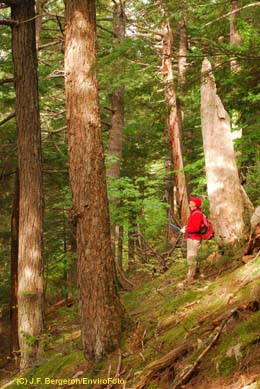
Old Growth
 Once a hallmark of the Acadian Forest, old growth has become rare. Under the Old-growth Forest Policy (effective 18 August 2022) about 30,000 hectares of old-growth forest and restoration opportunities on Crown Land are protected. Further, more than 280,000 hectares of actual and potential old-growth forest are in legally protected areas. Conservation of old forests on private land is actively encouraged and supported through several initiatives, while research is ongoing to develop tools, monitor progress, and better define old growth in different forest communities.
Once a hallmark of the Acadian Forest, old growth has become rare. Under the Old-growth Forest Policy (effective 18 August 2022) about 30,000 hectares of old-growth forest and restoration opportunities on Crown Land are protected. Further, more than 280,000 hectares of actual and potential old-growth forest are in legally protected areas. Conservation of old forests on private land is actively encouraged and supported through several initiatives, while research is ongoing to develop tools, monitor progress, and better define old growth in different forest communities.
Education resources
Policy resources
- Old-growth Forest Policy (PDF)
- Old-growth Forest Policy Interpretation Bulletin - 01-2022 (PDF)
- Old-growth Forest Policy Interpretation Bulletin - 02-2023 (PDF)
- Old Forest Policy Layer
- Old Forest Scoring Data (ZIP)
- Old Forest Scoresheet (PDF)
- Old Forest Scoring Procedures (PDF)
Research reports
- The Oldest Trees in the Maritimes - A Stand Analysis (PDF)
- Natural Succession of Red Oak Forests Research Report (PDF)
- Dendrochronologic Confirmation of Old Growth Hemlock Tree Age (October 2021) (PDF)
- Old Forest Assessment in the Lawlor Lake Area of Guysborough County (May. 2018) (PDF)
- Selected Nova Scotia old-growth forests: Age, ecology, structure, scoring (PDF) — A study of four old-growth stands in Nova Scotia was conducted to document the ecological characteristics of these currently rare Acadian forest ecosystems. Stands were selected to represent the two dominant climax forest types, hemlock-red spruce-eastern white pine, and sugar maple-yellow birch-beech.
- Coastal Forest Communities of the Nova Scotian Eastern Shore Ecodistrict (PDF) — This report examines some of the structures, processes of disturbance and succession, and flora of mature coastal forests in the Eastern Shore Ecodistrict that do not appear to have been shaped by past forest harvesting. This includes summaries of age structure, species composition, deadwood levels, and tree size distribution.